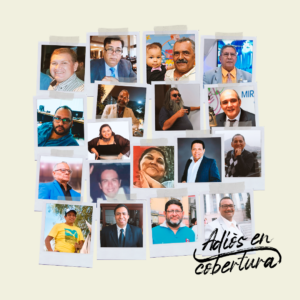Between March and August, 82 Peruvian journalists died from COVID-19 while covering the pandemic, according to the International Federation of Journalists (IFJ). Peru and Ecuador lead the list of 171 journalists killed by the virus in Latin America.

(Image: Canva)
Juan José Relmucao, communication manager at IFJ, told LatAm Journalism Review that despite the fact that this figure is due to the different factors and socioeconomic and health characteristics of each country, the cases of Latin American journalists killed by the virus have increased considerably in the last month.
"Since March we have been conducting periodic surveys on this issue and in our last effort we recorded the figure that was published, which is very high and that, surely and unfortunately, because of how difficult it is to track this data in real time, falls short," Relmucao said.
In addition to Peru, as of Aug. 19, IFJ recorded the number of journalists killed by COVID-19 in Ecuador (40), Mexico (13), Brazil (9), Honduras (7), the Dominican Republic (5), Guatemala (3), El Salvador (3), Nicaragua (3), Bolivia (2), Colombia (2), Argentina (1) and Panama (1).
The National Association of Journalists of Peru (ANP, for its acronym in Spanish), the National Union of Press Writers in Mexico, the Association of Journalists of El Salvador and the National Federation of Journalists of Brazil, among others, have provided the information for the IFJ report Relmucao mentioned.
As of July 1, the Geneva-based organization, Press Emblem Campaign, reported that Peru was the country with the most journalists killed by COVID-19 in the world, according to the Associated Press.
Distintas Latitudes, a journalistic organization that was born in Mexico, but brings together journalists from various parts of Latin America, investigated between July and September the deaths of colleagues who lost their lives to the pandemic.
With the information gathered, the organization created the microsite “Adiós en cobertura” (A goodbye in coverage), which it launched on Sept. 28 to pay tribute to the fallen journalists, according to its press release.
Health neglect and job insecurity are among the main conditions that contributed to a greater exposure to the viral infection of the deceased Latin American journalists, the organization said.

Micro site "Adiós en cobertura", from Distintas Latitudes.
In its first installment, Distintas Latitudes published 18 micro-profiles of journalists killed by COVID-19 from eight countries, a signature book open to colleagues and relatives, and a list with the names of the 100 journalists and communicators that the virus killed and that it managed to document.
The site will be updated between November and December with new profiles, according to the press release.
In Peru, between March 16 and Aug. 30, the ANP recorded 87 journalists killed by COVID-19 in that country. The number of dead Peruvian journalists is a reflection of what is happening in Peru, Zuliana Lainez, vice president of the IFJ and general secretary of the ANP, told LJR. According to data from John Hopkins University of Medicine in the U.S., Peru has the highest per capita COVID-19 death rate in the world.
In addition to the health and economic shortcomings of that South American country, another reason that makes the journalistic union of Peru one of the most impacted by the pandemic, Lainez explained, is the precariousness of the profession in the country.
"In Peru there is a very high level of precariousness of journalistic work, especially in the regions," Lainez said. "At least 70 percent of journalists are independent workers, who self-manage their work, that is, there is no company behind them that they can go to for personal protective equipment. So, they have been the ones who at the beginning of the pandemic have had to cover infectious foci with homemade masks," she added.
Through its 107 subsidiaries throughout the country, the ANP has managed to collect and confirm that of the 145 deceased journalists they recorded, 87 died from COVID-19 community spread. Additionally, the organization was able to confirm that of the 87 journalists who died, 37 of them were infected while covering the pandemic, and later died.
May was one of the most complicated months of the pandemic for Peruvian journalists, starting with the Peruvian jungle, Lainez said. “In Iquitos we began to have the first victims, in 14 days, 6 colleagues died. It was brutal.”
Currently, the health collapse caused by the pandemic in Peru is in the south, in the Departments of Arequipa, Cusco, Moquegua, Tacna and Puno, Lainez said.
“Many of the journalists who died during the COVID-19 pandemic are colleagues who are over 65 years old, that is, in practice they would have already retired. But in this country, an independent journalist from the regions is condemned to work until the last day of his life because he lives from day-to-day,” Lainez said.
The dean of the Lima Association of Journalists (CPL), Ricardo Burgos Rojas, said on its website that journalists are also on the front line in the fight against COVID-19, like doctors, health personnel, police and military personnel.
In mid-August, the CPL organized a virtual mass with a Catholic priest to pay tribute to 22 Peruvian journalists killed in Lima due to the virus, according to what the organization published on its website.
“The pandemic affects us all. For this reason, we consider that this act of prayer becomes a form of recognition for our colleagues who lost their lives in this tragic period,” Burgos wrote on the CPL website.
Christopher Barnes, president of the Inter-American Press Association (IAPA), called on all journalists, media outlets and press workers to reinforce their security protocols to reduce the impact of the pandemic on the profession.
In August, the IAPA dedicated the Press Freedom Grand Prize to the more than 100 Latin American journalists killed during the pandemic while carrying out their work.